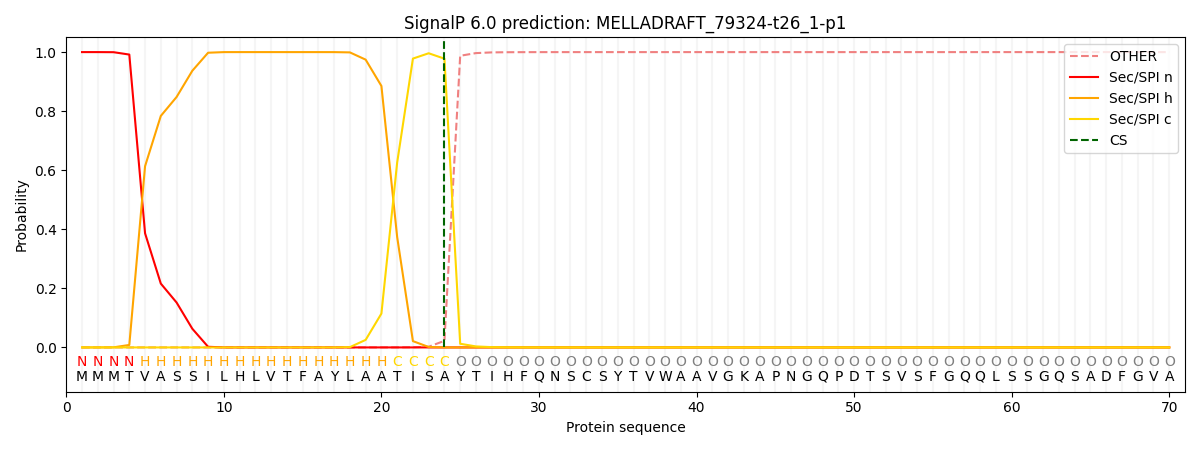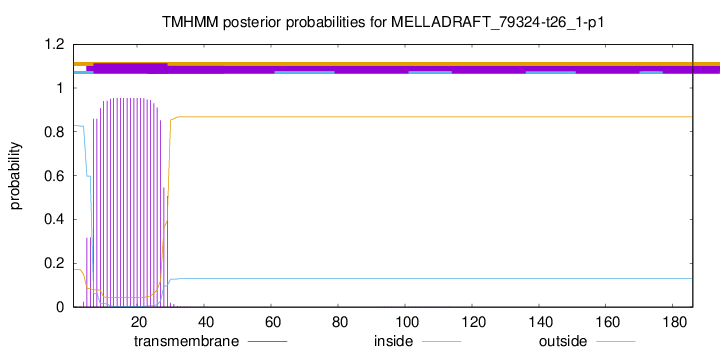You are browsing environment: FUNGIDB
CAZyme Information: MELLADRAFT_79324-t26_1-p1
You are here: Home > Sequence: MELLADRAFT_79324-t26_1-p1
Basic Information |
Genomic context |
Full Sequence |
Enzyme annotations |
CAZy signature domains |
CDD domains |
CAZyme hits |
PDB hits |
Swiss-Prot hits |
SignalP and Lipop annotations |
TMHMM annotations
Basic Information help
| Species | Melampsora larici-populina | |||||||||||
|---|---|---|---|---|---|---|---|---|---|---|---|---|
| Lineage | Basidiomycota; Pucciniomycetes; ; Melampsoraceae; Melampsora; Melampsora larici-populina | |||||||||||
| CAZyme ID | MELLADRAFT_79324-t26_1-p1 | |||||||||||
| CAZy Family | GH7 | |||||||||||
| CAZyme Description | thaumatin-like protein | |||||||||||
| CAZyme Property |
|
|||||||||||
| Genome Property |
|
|||||||||||
| Gene Location | ||||||||||||
CAZyme Signature Domains help
| Family | Start | End | Evalue | family coverage |
|---|---|---|---|---|
| GH152 | 31 | 160 | 3.2e-20 | 0.5925925925925926 |
CDD Domains download full data without filtering help
| Cdd ID | Domain | E-Value | qStart | qEnd | sStart | sEnd | Domain Description |
|---|---|---|---|---|---|---|---|
| 185756 | TLP-P | 5.25e-22 | 31 | 185 | 5 | 150 | thaumatin and allergenic/antifungal thaumatin-like proteins: plant homologs. This subfamily is represented by the sweet-tasting protein thaumatin from the African berry Thaumatococcus daniellii, allergenic/antifungal Thaumatin-like proteins (TLPs), and related plant proteins. TLPs are involved in host defense and a wide range of developmental processes in fungi, plants, and animals. Plant TLPs are classified as pathogenesis-related (PR) protein family 5 (PR5), their expression is induced by environmental stresses such as pathogen/pest attack, drought and cold. TLPs in this subfamily include such proteins as zeamatin, found in high concentrations in cereal seeds, and osmotin, a salt-induced protein in osmotically stressed plants. Several members of the plant TLP family have been reported as food allergens from fruits (i.e., cherry, Pru av 2; bell pepper, Cap a1; tomatoes, Lyc e NP24) and pollen allergens from conifers (i.e., mountain cedar, Jun a 3; Arizona cypress, Cup a3; Japanese cedar, Cry j3). Thaumatin and TLPs are three-domain, crescent-fold structures with either an electronegative, electropositive, or neutral cleft occurring between domains I and II. It has been proposed that the antifungal activity of plant PR5 proteins relies on the strong electronegative character of this cleft. IgE-binding epitopes of mountain Cedar (Juniperus ashei) allergen Jun a 3, which interact with pooled IgE from patients suffering allergenic response to this allergen, were mainly located on the helical domain II; the best-conserved IgE-binding epitope predicted for TLPs corresponds to this region. Some TLPs hydrolyze the beta-1,3-glucans of the type commonly found in fungal walls. Most TLPs contain 16 conserved Cys residues. A deletion within the third domain (domain II) of the Triticum aestivum thaumatin-like xylanase inhibitor is observed, thus, only 10 conserved Cys residues are present within this smaller TLP and similar homologs. |
| 395248 | Thaumatin | 2.86e-20 | 31 | 157 | 1 | 130 | Thaumatin family. |
| 185754 | Thaumatin-like | 3.02e-18 | 27 | 185 | 1 | 157 | the sweet-tasting protein, thaumatin, and thaumatin-like proteins involved in host defense. This family is represented by the sweet-tasting protein thaumatin from the African berry Thaumatococcus daniellii and thaumatin-like proteins (TLPs) involved in host defense and a wide range of developmental processes in fungi, plants, and animals. Plant TLPs are classified as pathogenesis-related (PR) protein family 5 (PR5), their expression is induced by environmental stresses such as pathogen/pest attack, drought and cold. TLPs included in this family are such proteins as zeamatin, found in high concentrations in cereal seeds; osmotin, a salt-induced protein in osmotically stressed plants; and PpAZ44, a propylene-induced TLP in abscission of young fruit. Several members of the plant TLP family have been reported as food allergens from fruits (i.e., cherry, Pru av 2; bell pepper, Cap a1; tomatoes, Lyc e NP24) and pollen allergens from conifers (i.e., mountain cedar, Jun a 3; Arizona cypress, Cup a3; Japanese cedar, Cry j3). Thaumatin and TLPs are three-domain, crescent-fold structures with either an electronegative, electropositive, or neutral cleft occurring between domains I and II. It has been proposed that the antifungal activity of plant PR5 proteins relies on the strong electronegative character of this cleft. Some TLPs hydrolyze the beta-1,3-glucans of the type commonly found in fungal walls. Most TLPs contain 16 conserved Cys residues. A deletion within the third domain (domain II) of the Triticum aestivum thaumatin-like xylanase inhibitor is observed, thus, only 10 conserved Cys residues are present within this smaller TLP and similar homologs. |
| 185757 | TLP-PA | 8.83e-18 | 26 | 157 | 1 | 131 | allergenic/antifungal thaumatin-like proteins: plant and animal homologs. This subfamily is represented by the thaumatin-like proteins (TLPs), Cherry Allergen Pru Av 2 TLP, Peach PpAZ44 TLP (a propylene-induced TLP in abscission), the Caenorhabditis elegans thaumatin family member (thn-6), and other plant and animal homologs. TLPs are involved in host defense and a wide range of developmental processes in fungi, plants, and animals. Due to their inducible expression by environmental stresses such as pathogen/pest attack, drought and cold, plant TLPs are classified as the pathogenesis-related (PR) protein family 5 (PR5). Several members of the plant TLP family have been reported as food allergens from fruits (i.e., cherry, Pru av 2; bell pepper, Cap a1; tomatoes, Lyc e NP24) and pollen allergens from conifers (i.e., mountain cedar, Jun a 3; Arizona cypress, Cup a3; Japanese cedar, Cry j3). TLPs are three-domain, crescent-fold structures with either an electronegative, electropositive, or neutral cleft occurring between domains I and II. It has been proposed that the antifungal activity of plant PR5 proteins relies on the strong electronegative character of this cleft. Some TLPs hydrolyze the beta-1,3-glucans of the type commonly found in fungal walls. TLPs within this subfamily contain 16 conserved Cys residues. |
| 128501 | THN | 2.50e-17 | 27 | 158 | 1 | 139 | Thaumatin family. The thaumatin family gathers proteins related to plant pathogenesis. The thaumatin family includes very basic members with extracellular and vacuolar localization. Thaumatin itsel is a potent sweet-tasting protein. Several members of this family display significant in vitro activity of inhibiting hyphal growth or spore germination of various fungi probably by a membrane permeabilizing mechanism. |
CAZyme Hits help
| Hit ID | E-Value | Query Start | Query End | Hit Start | Hit End |
|---|---|---|---|---|---|
| 9.92e-65 | 19 | 185 | 13 | 177 | |
| 4.38e-16 | 17 | 158 | 6 | 144 | |
| 9.18e-16 | 17 | 158 | 15 | 153 | |
| 1.78e-15 | 18 | 158 | 16 | 153 | |
| 4.05e-15 | 19 | 146 | 10 | 142 |
PDB Hits download full data without filtering help
| Hit ID | E-Value | Query Start | Query End | Hit Start | Hit End | Description |
|---|---|---|---|---|---|---|
| 5.87e-16 | 26 | 157 | 2 | 130 | Resolution of the structure of the allergenic and antifungal banana fruit thaumatin-like protein at 1.7A [Musa acuminata] |
|
| 2.23e-13 | 26 | 157 | 2 | 126 | Structure of haze forming proteins in white wines: Vitis vinifera thaumatin-like proteins [Vitis vinifera],4L5H_B Structure of haze forming proteins in white wines: Vitis vinifera thaumatin-like proteins [Vitis vinifera],4MBT_A Structure of haze forming proteins in white wines: Vitis vinifera thaumatin-like proteins [Vitis vinifera],4MBT_B Structure of haze forming proteins in white wines: Vitis vinifera thaumatin-like proteins [Vitis vinifera] |
|
| 6.27e-13 | 26 | 138 | 2 | 106 | Structure of haze forming proteins in white wines: Vitis vinifera thaumatin-like proteins [Vitis vinifera] |
|
| 1.30e-11 | 26 | 157 | 2 | 135 | Structure of hyper-sweet thaumatin (D21N) [Thaumatococcus daniellii] |
|
| 1.30e-11 | 26 | 157 | 2 | 135 | Structure of VIL-thaumatin [Thaumatococcus daniellii] |
Swiss-Prot Hits download full data without filtering help
| Hit ID | E-Value | Query Start | Query End | Hit Start | Hit End | Description |
|---|---|---|---|---|---|---|
| 3.16e-16 | 18 | 158 | 16 | 153 | Osmotin-like protein OSM34 OS=Arabidopsis thaliana OX=3702 GN=OSM34 PE=2 SV=2 |
|
| 1.74e-15 | 17 | 156 | 18 | 145 | Pathogenesis-related protein R minor form OS=Nicotiana tabacum OX=4097 PE=2 SV=1 |
|
| 6.52e-15 | 17 | 156 | 18 | 145 | Pathogenesis-related protein R major form OS=Nicotiana tabacum OX=4097 PE=1 SV=1 |
|
| 3.40e-10 | 26 | 157 | 24 | 157 | Thaumatin I OS=Thaumatococcus daniellii OX=4621 PE=1 SV=2 |
|
| 3.40e-10 | 26 | 157 | 24 | 157 | Thaumatin II OS=Thaumatococcus daniellii OX=4621 PE=1 SV=1 |
SignalP and Lipop Annotations help
This protein is predicted as SP

| Other | SP_Sec_SPI | CS Position |
|---|---|---|
| 0.000245 | 0.999749 | CS pos: 24-25. Pr: 0.9777 |

